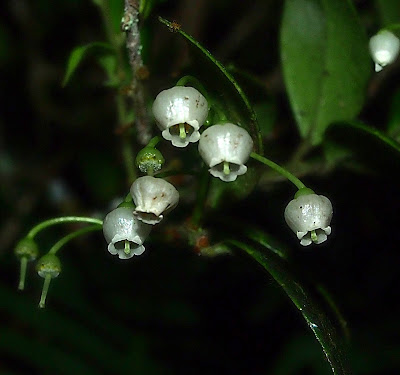First bloom on an Echidnopsis ericiflora cutting
Last Nov. 21, 2017, I was given an unrooted and unbranched cutting of an unnamed Echidnopsis. As I knew that there are species from this genus that are found on red soils, and surmised that such substrates are of that color due to the presence of oxidized iron. Fortunately for me, I have some chunks of laterite which I thought may provide the iron the plant probably yearns for. So I potted it using small pumice stones, pumice sand, and laterite, then added three pellets of time-release balanced fertilizer. Like most of my succulents, it was given no special treatment and was left unprotected from the sun for about eight hours everyday. December was a rainy month in our place and damn me if I am lying, but not a day passed without precipitation. It was sunny on Christmas day until it rained at about 9 PM. Most of my succulents, including this Echidnopsis, were given no protection from the daily rains.
By the end of February I noticed a single, tiny bud forming which opened yesterday, March 8. I was able to immediately identify it as E. ericiflora, an East African species. Now, that's a little over three months after its acquisition, and the plant has produced a flower as reward for my care. But not quick enough, as an Orbea baldrattii and a Huernia insigniflora, both also passed on to me as unrooted cuttings on Nov. 21, flowered in early February, or less than two months after being potted. But hey, I ain't complaining- except for the fact that the corolla lobes do not reflex like those in photos I have seen of this species. At any rate, I observed some really tiny ants making trips to the inside of the flower.
The species name ericiflora is an allusion to the flowers' resemblance to the blooms of heaths (Family Ericaceae). Below is a species Vaccinium from Zambales, western Luzon. The flowers are sweetly fragrant at night.
And yet, in my opinion, one does not have to look far when looking for similar flowers. Within the same family, Apocynaceae (to which all stapeliads also belong), we find the genus Dischidia, which contain many species with similarly urceolate flowers. Here is an example for your perusal, a D. hirsuta flower:
Told 'ya 😊
By the end of February I noticed a single, tiny bud forming which opened yesterday, March 8. I was able to immediately identify it as E. ericiflora, an East African species. Now, that's a little over three months after its acquisition, and the plant has produced a flower as reward for my care. But not quick enough, as an Orbea baldrattii and a Huernia insigniflora, both also passed on to me as unrooted cuttings on Nov. 21, flowered in early February, or less than two months after being potted. But hey, I ain't complaining- except for the fact that the corolla lobes do not reflex like those in photos I have seen of this species. At any rate, I observed some really tiny ants making trips to the inside of the flower.
The species name ericiflora is an allusion to the flowers' resemblance to the blooms of heaths (Family Ericaceae). Below is a species Vaccinium from Zambales, western Luzon. The flowers are sweetly fragrant at night.
And yet, in my opinion, one does not have to look far when looking for similar flowers. Within the same family, Apocynaceae (to which all stapeliads also belong), we find the genus Dischidia, which contain many species with similarly urceolate flowers. Here is an example for your perusal, a D. hirsuta flower:
Told 'ya 😊






Comments
Post a Comment